Controlling Nanostructure in Inkjet Printed Organic Transistors for Pressure Sensing Applications
Abstract
1. Introduction
2. Materials and Methods
2.1. QTC Pressure Sensing Element Calibration
2.2. OTFT Construction
2.3. OTFT Characterisation
3. Results and Discussion
3.1. Characterisation of Transmission Fuse Output and QTC Sensor Response
3.2. Characterisation of the Printed OTFT Sensing and Signalling System
3.3. Integrating the QTC Sensor into the OTFT
4. Conclusions
Author Contributions
Funding
Institutional Review Board Statement
Informed Consent Statement
Data Availability Statement
Acknowledgments
Conflicts of Interest
References
- Briseno, A.L.; Mannsfeld, S.C.B.; Jenekhe, S.A.; Bao, Z.; Xia, Y. Introducing Organic Nanowire Transistors. Mater. Today 2008, 11, 38–47. [Google Scholar] [CrossRef]
- Lee, M.Y.; Lee, H.R.; Park, C.H.; Han, S.G.; Oh, J.H. Organic Transistor-Based Chemical Sensors for Wearable Bioelectronics. Acc. Chem. Res. 2018, 51, 2829–2838. [Google Scholar] [CrossRef] [PubMed]
- Griffith, M.J.; Holmes, N.P.; Elkington, D.C.; Cottam, S.; Stamenkovic, J.; Kilcoyne, A.L.D.; Andersen, T.R. Manipulating nanoscale structure to control functionality in printed organic photovoltaic, transistor and bioelectronic devices. Nanotechnology 2020, 31, 092002. [Google Scholar] [CrossRef] [PubMed]
- Ameri, M.; Al-Mudhaffer, M.F.; Almyahi, F.; Fardell, G.C.; Marks, M.; Al-Ahmad, A.; Fahy, A.; Andersen, T.; Elkington, D.C.; Feron, K.; et al. Role of Stabilizing Surfactants on Capacitance, Charge, and Ion Transport in Organic Nanoparticle-Based Electronic Devices. ACS Appl. Mater. Interfaces 2019, 11, 10074–10088. [Google Scholar] [CrossRef] [PubMed]
- Kergoat, L.; Piro, B.; Berggren, M.; Horowitz, G.; Pham, M.-C. Advances in Organic Transistor Based Biosensors: From Organic Electrochemical Transistors to Electrolyte-Gated Organic Field-Effect Transistors. Anal. Bioanal. Chem. 2012, 402, 1813–1826. [Google Scholar] [CrossRef]
- Marks, M.; Holmes, N.P.; Sharma, A.; Pan, X.; Chowdhury, R.; Barr, M.G.; Fenn, C.; Griffith, M.J.; Feron, K.; Kilcoyne, A.L.D.; et al. Building intermixed donor-acceptor architectures for water-processable organic photovoltaics. Phys. Chem. Chem. Phys. 2019, 21, 5705–5715. [Google Scholar] [CrossRef]
- Wang, L.; Fine, D.; Sharma, D.; Torsi, L.; Dodabalapur, A. Nanoscale organic and polymeric field-effect transistors as chemical sensors. Anal. Bioanal. Chem. 2006, 384, 310–321. [Google Scholar] [CrossRef]
- Griffith, M.J.; Sunahara, K.; Furube, A.; Mozer, A.J.; Officer, D.L.; Wagner, P.; Wallace, G.G.; Mori, S. Cation Exchange at Semiconducting Oxide Surfaces: Origin of Light-Induced Performance Increases in Porphyrin Dye-Sensitized Solar Cells. J. Phys. Chem. C 2013, 117, 11885–11898. [Google Scholar] [CrossRef][Green Version]
- Hösel, M.; Krebs, F.C. Large-scale roll-to-roll photonic sintering of flexo printed silver nanoparticle electrodes. J. Mater. Chem. 2012, 22, 15683–15688. [Google Scholar] [CrossRef]
- Griffith, M.J.; Cooling, N.A.; Vaughan, B.; Elkington, D.C.; Hart, A.S.; Lyons, A.G.; Quereshi, S.; Belcher, W.J.; Dastoor, P.C. Combining Printing, Coating, and Vacuum Deposition on the Roll-to-Roll Scale: A Hybrid Organic Photovoltaics Fabrication. IEEE J. Sel. Top. Quantum Electron. 2016, 22, 112–125. [Google Scholar] [CrossRef]
- Griffith, M.J.; Cooling, N.A.; Vaughan, B.; O’Donnell, K.M.; Al-Mudhaffer, M.F.; Al-Ahmad, A.; Noori, M.; Almyahi, F.; Belcher, W.J.; Dastoor, P.C. Roll-to-Roll Sputter Coating of Aluminum Cathodes for Large-Scale Fabrication of Organic Photovoltaic Devices. Energy Technol. 2015, 3, 428–436. [Google Scholar] [CrossRef]
- Andersen, T.R.; Almyahi, F.; Cooling, N.A.; Elkington, D.; Wiggins, L.; Fahy, A.; Feron, K.; Vaughan, B.; Griffith, M.J.; Mozer, A.J.; et al. Comparison of inorganic electron transport layers in fully roll-to-roll coated/printed organic photovoltaics in normal geometry. J. Mater. Chem. A 2016, 4, 15986–15996. [Google Scholar] [CrossRef]
- Baran, D.; Ashraf, R.S.; Hanifi, D.A.; Abdelsamie, M.; Gasparini, N.; Rohr, J.A.; Holliday, S.; Wadsworth, A.; Lockett, S.; Neophytou, M.; et al. Reducing the efficiency-stability-cost gap of organic photovoltaics with highly efficient and stable small molecule acceptor ternary solar cells. Nat. Mater. 2017, 16, 363–369. [Google Scholar] [CrossRef] [PubMed]
- Holmes, N.P.; Vaughan, B.; Williams, E.L.; Kroon, R.; Anderrson, M.R.; Kilcoyne, A.L.D.; Sonar, P.; Zhou, X.; Dastoor, P.C.; Belcher, W.J. Diketopyrrolopyrrole-based polymer:fullerene nanoparticle films with thermally stable morphology for organic photovoltaic applications. MRS Commun. 2017, 7, 67–73. [Google Scholar] [CrossRef]
- Yin, W.; Dadmun, M. A new model for the morphology of P3HT/PCBM organic photovoltaics from small-angle neutron scattering: Rivers and streams. ACS Nano. 2011, 5, 4756–4768. [Google Scholar] [CrossRef]
- Zhou, L.; He, X.; Lau, T.K.; Qiu, B.; Wang, T.; Lu, X.; Luszczynska, B.; Ulanski, J.; Xu, S.; Chen, G.; et al. Nonhalogenated Solvent-Processed All-Polymer Solar Cells over 7.4% Efficiency from Quinoxaline-Based Polymers. ACS Appl. Mater. Interfaces 2018, 10, 41318–41325. [Google Scholar] [CrossRef]
- Cho, J.H.; Lee, J.; Xia, Y.; Kim, B.; He, Y.; Renn, M.J.; Lodge, T.P.; Frisbie, C.D. Printable ion-gel gate dielectrics for low-voltage polymer thin-film transistors on plastic. Nat. Mater. 2008, 7, 900–906. [Google Scholar] [CrossRef]
- Elkington, D.; Wasson, M.; Belcher, W.; Dastoor, P.C.; Zhou, X. Printable organic thin film transistors for glucose detection incorporating inkjet-printing of the enzyme recognition element. Appl. Phys. Lett. 2015, 106, 64. [Google Scholar] [CrossRef]
- Maasoumi, F.; Ullah, M.; Shaw, P.E.; Li, J.; Burn, P.L.; Meredith, P.; Namdas, E.B. Charge transport and recombination in heterostructure organic light emitting transistors. Org. Electron. 2015, 25, 37–43. [Google Scholar] [CrossRef]
- Someya, T.; Sekitani, T.; Iba, S.; Kato, Y.; Kawaguchi, H.; Sakurai, T. A large-area, flexible pressure sensor matrix with organic field-effect transistors for artificial skin applications. Proc. Natl. Acad. Sci. USA 2004, 101, 9966–9970. [Google Scholar] [CrossRef]
- Mabrook, M.F.; Pearson, C.; Petty, M.C. Inkjet-Printed Polymer Films for the Detection of Organic Vapors. IEEE Sens. J. 2006, 6, 1435–1444. [Google Scholar] [CrossRef]
- Thompson, B.; Yoon, H.-S. Aerosol-Printed Strain Sensor Using PEDOT:PSS. IEEE Sens. J. 2013, 13, 4256–4263. [Google Scholar] [CrossRef]
- Griffith, M.J.; Cooling, N.A.; Elkington, D.C.; Muller, E.; Belcher, W.J.; Dastoor, P.C. Printable Sensors for Explosive Detonation. Appl. Phys. Lett. 2014, 105, 143301. [Google Scholar] [CrossRef]
- Sekitani, T.; Someya, T. Stretchable, Large-area Organic Electronics. Adv. Mater. 2010, 22, 2228–2246. [Google Scholar] [CrossRef] [PubMed]
- Someya, T.; Kato, Y.; Iba, S.; Noguchi, Y.; Sekitani, T.; Kawaguchi, H.; Sakurai, T. Integration of organic FETs with organic photodiodes for a large area, flexible, and lightweight sheet image scanners. IEEE Trans. Electron. Dev. 2005, 52, 2502–2511. [Google Scholar] [CrossRef]
- Sekitani, T.; Noguchi, Y.; Zschieschang, U.; Klauk, H.; Someya, T. Organic transistors manufactured using inkjet technology with subfemtoliter accuracy. Proc. Natl. Acad. Sci. USA 2008, 105, 4976–4980. [Google Scholar] [CrossRef]
- Babu, A.S.; Mishra, K.K.; Kshirsagar, P.D.; Shekhar, H.; Rasane, V.S. Programmable Electronic Delay Device for Detonator. Defence Sci. J. 2013, 63, 305–307. [Google Scholar] [CrossRef][Green Version]
- Kichouliya, R.; Devender, R.; Ramasarma, V.V.; Reddy, D.S.; Borkar, V.G. Hazards of electromagnetic radiation to ordnance (HERO) assessment of electro-explosive devices and validation of extrapolation method for estimation of the safety margin at HERO electromagnetic environments. In Proceedings of the 2011 IEEE International Symposium on Electromagnetic Compatibility, Long Beach, CA, USA, 14–19 August 2011; pp. 946–953. [Google Scholar]
- Pantoja, J.J.; Peña, N.M.; Rachidi, F.; Vega, F.; Roman, F. Susceptibility of Electro-explosive Devices to Microwave Interference. Defence Sci. J. 2013, 63, 386–392. [Google Scholar] [CrossRef]
- Mishra, P.K.; Miodrag, B.; Mustapha, C.E.; Yagoub, S.R.F. RFID technology for tracking and tracing explosives and detonators in mining services applications. J. Appl. Geophys. 2012, 76, 33–43. [Google Scholar] [CrossRef]
- Smit, F.C.; Pistorius, C.W.I. Implications of the Dominant Design in Electronic Initiation Systems in the South African Mining Industry. Technol. Forecast. Soc. 1998, 59, 255–274. [Google Scholar] [CrossRef]
- Zhu, P.; Shen, R.; Fiadosenka, N.N.; Ye, Y.; Hu, Y. Dielectric structure pyrotechnic initiator realized by integrating Ti/CuO-based reactive multilayer films. J. Appl. Phys. 2011, 109, 084523. [Google Scholar] [CrossRef]
- Freiwald, D.A. Approximate Blast Wave Theory and Experimental Data for Shock Trajectories in Linear Explosive-Driven Shock Tubes. J. Appl. Phys. 1972, 43, 2224–2226. [Google Scholar] [CrossRef]
- Westbrook, C.K. An Analytical Study of the Shock Tube Ignition of Mixtures of Methane and Ethane. Combust. Sci. Technol. 1979, 20, 5–17. [Google Scholar] [CrossRef]
- Samuelraj, I.O.; Jagadeesh, G.; Kontis, K. Micro-blast waves using detonation transmission tubing. Shock Waves 2013, 23, 307–316. [Google Scholar] [CrossRef]
- Mabeck, J.T.; Malliaras, G.G. Chemical and biological sensors based on organic thin-film transistors. Anal. Bioanal. Chem. 2006, 384, 343–353. [Google Scholar] [CrossRef] [PubMed]
- Samuel, I.D.W. Polymer Electronics. Phil. Trans. Royal Soc. A 2000, 358, 193–210. [Google Scholar] [CrossRef]
- Cho, B.; Kim, T.-W.; Song, S.; Ji, Y.; Jo, M.; Hwang, H.; Jung, G.-Y.; Lee, T. Rewritable Switching of One Diode-One Resistor Nonvoltaile Organic Memory Devices. Adv. Mater. 2010, 22, 1228–1232. [Google Scholar] [CrossRef]
- DeFranco, J.A.; Schmidt, B.S.; Lipson, M.; Malliaras, G.G. Photolithographic Patterning of Organic Electronic Materials. Org. Electron. 2006, 7, 22–28. [Google Scholar] [CrossRef]
- Abdolmaleki, H.; Kidmose, P.; Agarwala, S. Droplet-based techniques for printing of functional inks for flexible physical sensors. Adv. Mater. 2021, 2006792. [Google Scholar] [CrossRef]
- Kamyshny, A.; Magdassi, S. Conductive nanomaterials for printed electronics. Small 2014, 10, 3515–3535. [Google Scholar] [CrossRef]
- Gans, B.J.; Duineveld, P.C.; Schubert, U.S. Inkjet printing of polymers: State of the art and future developments. Adv. Mater. 2004, 16, 203–213. [Google Scholar] [CrossRef]
- Abdolmaleki, H.; Agarwala, S. PVDF-BaTiO3 nanocomposite inkjet inks with enhanced phase crystallinity for printed electronics. Polymers 2020, 12, 2430. [Google Scholar] [CrossRef] [PubMed]
- Yu, G.; Cao, Y.; Wang, J.; McElvain, J.; Heeger, A.J. High sensitivity polymer photosensors for image sensing applications. Synth. Met. 1999, 102, 904–907. [Google Scholar] [CrossRef]
- Labram, J.; Wöbkenberg, P.; Bradley, D.; Anthopoulos, T. Low-voltage ambipolar phototransistors based on a pentacene/PC61BM heterostructure and a self-assembled nano-dielectric. Org. Electron. 2010, 11, 1250–1254. [Google Scholar] [CrossRef]
- Manunza, I.; Sulis, A.; Bonfiglio, A. Pressure sensing by flexible, organic, field effect transistors. Appl. Phys. Lett. 2006, 89, 143502. [Google Scholar] [CrossRef]
- Manunza, I.; Bonfiglio, A. Pressure sensing using a completely flexible organic transistor. Biosens. Bioelectron. 2007, 22, 2775–2779. [Google Scholar] [CrossRef] [PubMed]
- Jing, X.; Zhao, W.; Lan, L. The effect of particle size on electric conducting percolation threshold in polymer/conducting particle composites. J. Mater. Sci. Lett. 2000, 19, 377–379. [Google Scholar] [CrossRef]
- Ounaies, Z.; Park, C.; Wise, K.E.; Siochi, E.J.; Harrison, J.S. Electrical properties of single wall carbon nanotube reinforced polyimide composites. Compos. Sci. Technol. 2003, 63, 1637–1646. [Google Scholar] [CrossRef]
- Hwang, M.; Lee, H.S.; Jang, Y.; Cho, J.H.; Lee, S.; Kim, D.H.; Cho, K. Effect of curing conditions of a poly(4-vinylphenol) gate dielectric on the performance of a pentacene-based thin film transistor. Macromol. Res. 2009, 17, 436–440. [Google Scholar] [CrossRef]
- Forde, L.C.; Proud, W.G.; Walley, S.M.; Church, P.D.; Cullis, I.G. Ballistic impact studies of a borosilicate glass. Int. J. Impact Eng. 2010, 37, 568–578. [Google Scholar] [CrossRef][Green Version]
- Sutton, D.; Noble, A.H.; Lynch, P.M. Studies of Explosive Shock Tubes. In Proceedings of the 14th International Pyrotechnic Seminar, Channel Islands, UK, 18–22 September 1989; pp. 627–636. [Google Scholar]
- Tsang, D.K.L. A numerical study of a detonation wave in detonation transmission tubing. Math. Comp. Model. 2006, 44, 717–734. [Google Scholar] [CrossRef]
- Eckhoff, R.K. Minimum ignition energy (MIE)—A basic ignition sensitivity parameter in design of intrinsically safe electrical apparatus for explosive dust clouds. J. Loss Prevent. Proc. Indust. 2002, 15, 305–310. [Google Scholar] [CrossRef]
- Elkington, D.; Darwis, D.; Zhou, X.; Belcher, W.; Dastoor, P.C. The fabrication and characterization of poly(4-vinylpyridine)-based thin film transistors exhibiting enhanced ion modulation. Org. Electron. 2012, 13, 153–158. [Google Scholar] [CrossRef]
- Bäcklund, T.G.; Österbacka, R.; Stubb, H.; Bobacka, J.; Ivaska, A. Operating principle of polymer insulator organic thin-film transistors exposed to moisture. J. Appl. Phys. 2005, 98, 074504. [Google Scholar] [CrossRef]
- Jaczewska, J.; Raptis, I.; Budkowski, A.; Goustouridis, D.; Raczkowska, J.; Sanopoulou, M.; Pamula, E.; Bernasik, A.; Rysz, J. Swelling of poly(3-alkylthiophene) films exposed to solvent vapors and humidity: Evaluation of solubility parameters. Synth. Met. 2007, 157, 726–732. [Google Scholar] [CrossRef]
- Destri, G.L.; Keller, T.F.; Catellani, M.; Punzo, F.; Jandt, K.D.; Marletta, G. Crystalline monolayer ordering at substrate/polymer interfaces in poly(3-hexylthiophene) ultrathin films. Macromol. Chem. Phys. 2011, 212, 905–914. [Google Scholar] [CrossRef]
- Kim, H.; Yoon, B.; Sung, J.; Choi, D.G.; Park, C. Micropatterning of thin P3HT films via plasma enhanced polymer transfer printing. J. Mater. Chem. 2008, 18, 3489–3495. [Google Scholar] [CrossRef]
- Taghizadeh, M.; Amiri, S.S. Experimental measurements and modelling of the solvent activity and surface tension of binary mixtures of poly(vinyl pyrrolidone) in water and ethanol. J. Serb. Chem. Soc. 2017, 82, 427–435. [Google Scholar] [CrossRef][Green Version]
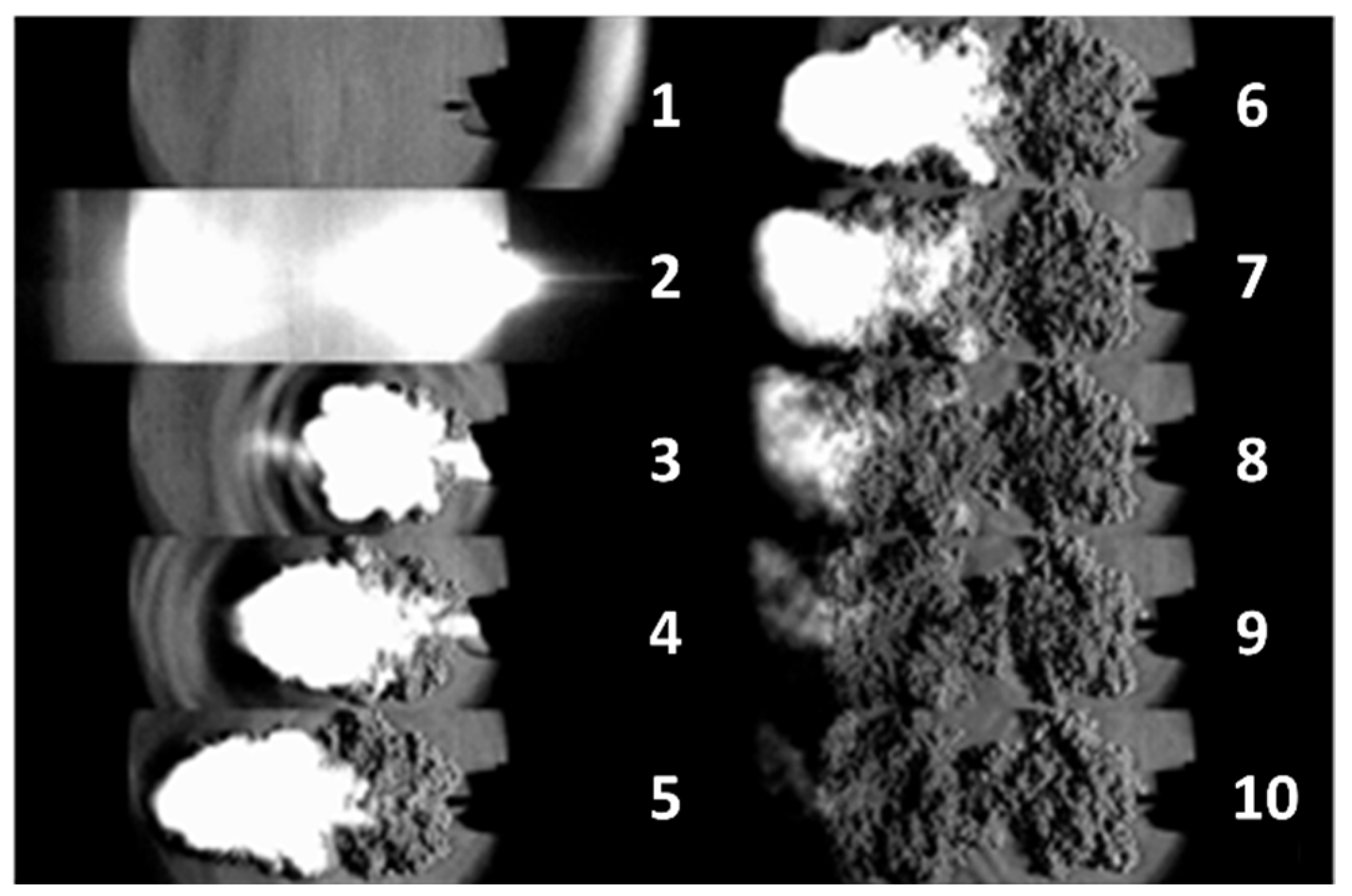
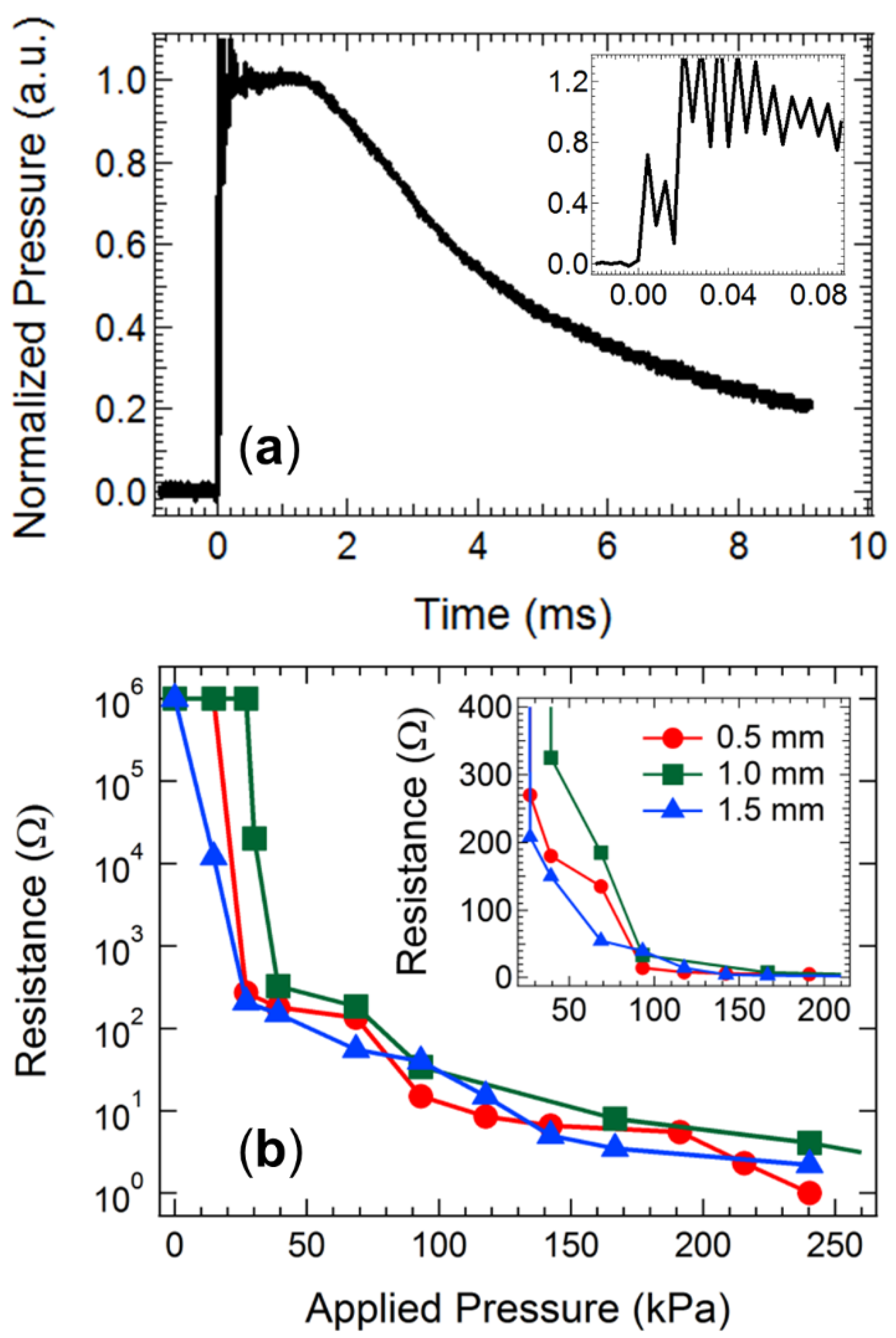
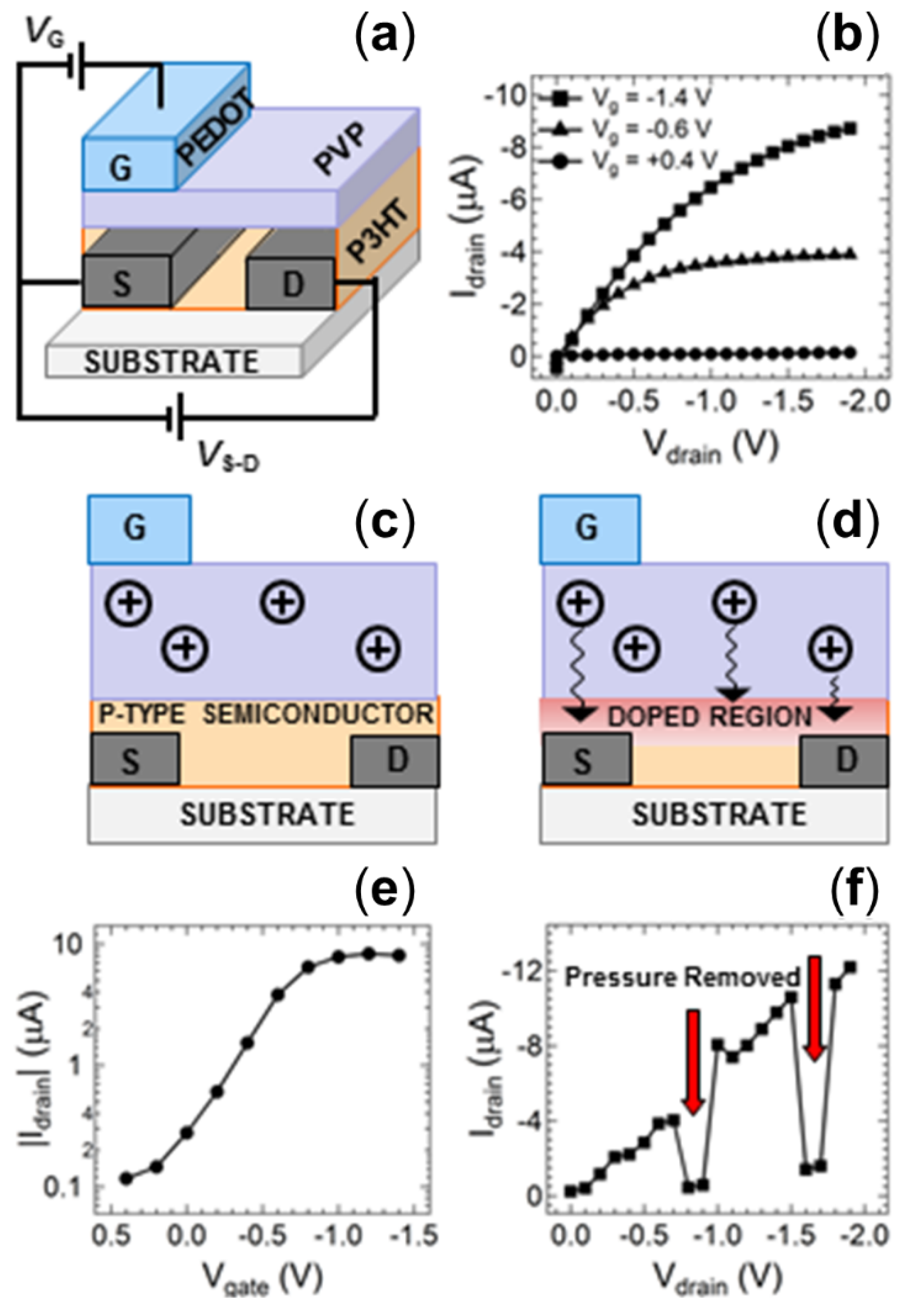
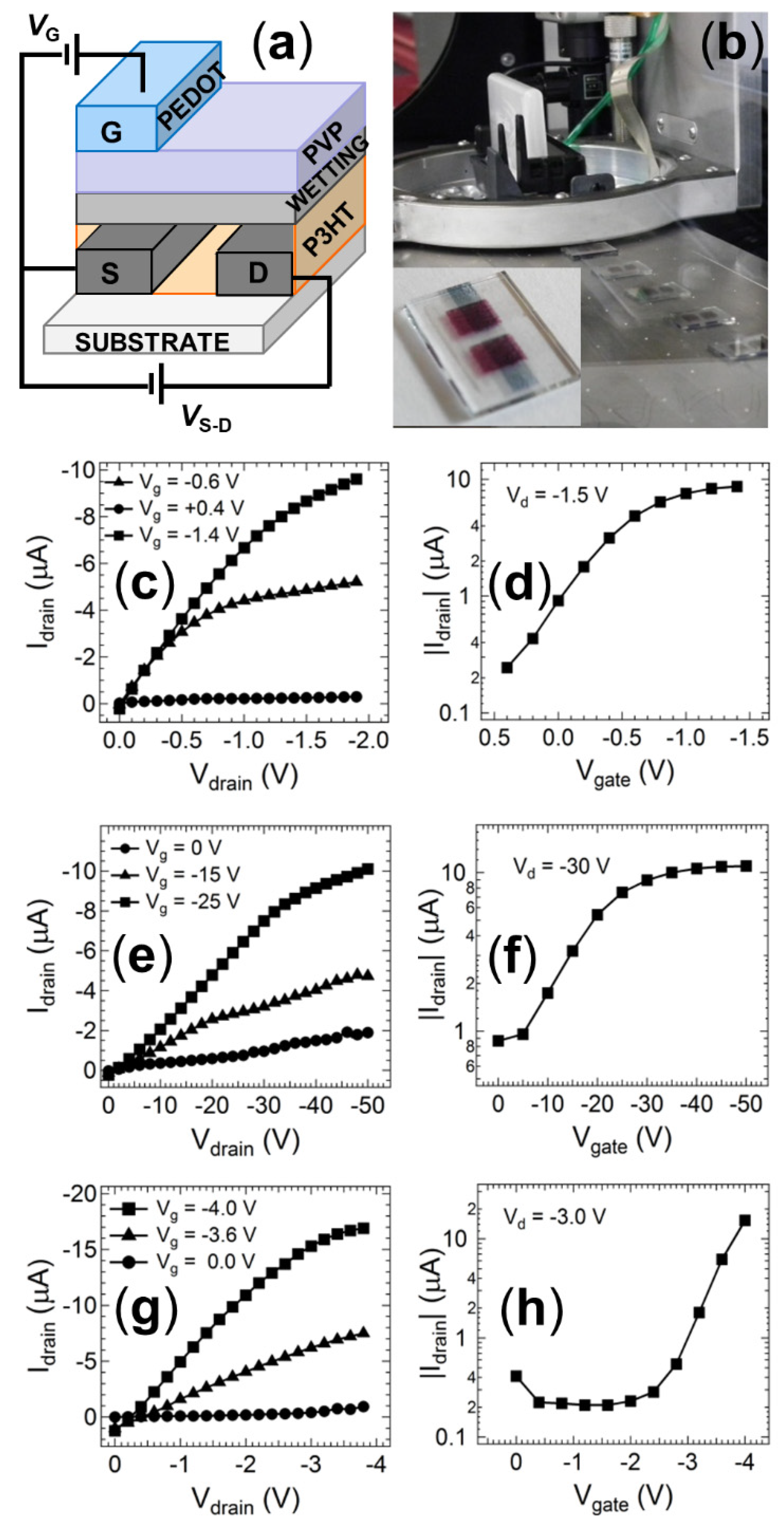


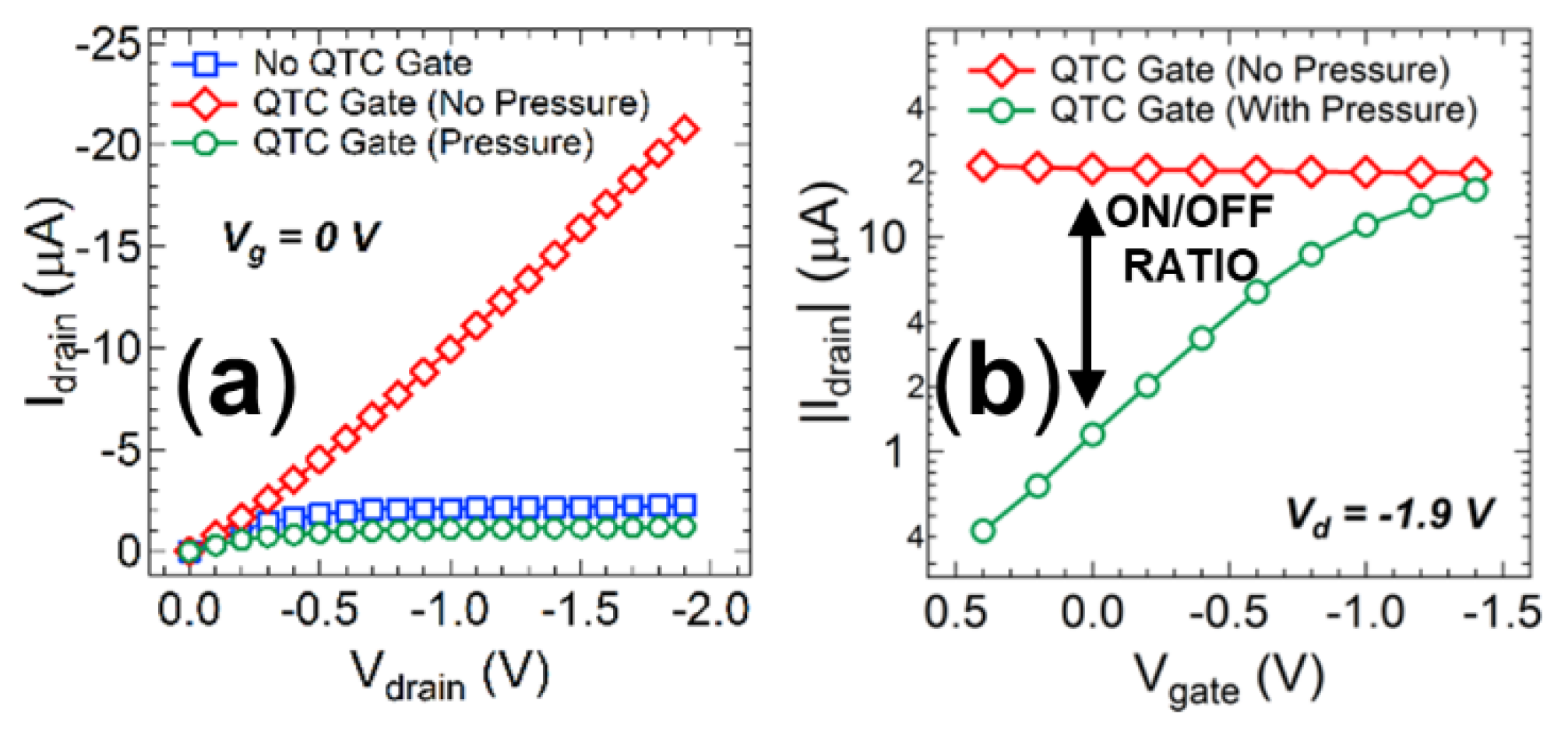
Publisher’s Note: MDPI stays neutral with regard to jurisdictional claims in published maps and institutional affiliations. |
© 2021 by the authors. Licensee MDPI, Basel, Switzerland. This article is an open access article distributed under the terms and conditions of the Creative Commons Attribution (CC BY) license (https://creativecommons.org/licenses/by/4.0/).
Share and Cite
Griffith, M.J.; Cooling, N.A.; Elkington, D.C.; Wasson, M.; Zhou, X.; Belcher, W.J.; Dastoor, P.C. Controlling Nanostructure in Inkjet Printed Organic Transistors for Pressure Sensing Applications. Nanomaterials 2021, 11, 1185. https://doi.org/10.3390/nano11051185
Griffith MJ, Cooling NA, Elkington DC, Wasson M, Zhou X, Belcher WJ, Dastoor PC. Controlling Nanostructure in Inkjet Printed Organic Transistors for Pressure Sensing Applications. Nanomaterials. 2021; 11(5):1185. https://doi.org/10.3390/nano11051185
Chicago/Turabian StyleGriffith, Matthew J., Nathan A. Cooling, Daniel C. Elkington, Michael Wasson, Xiaojing Zhou, Warwick J. Belcher, and Paul C. Dastoor. 2021. "Controlling Nanostructure in Inkjet Printed Organic Transistors for Pressure Sensing Applications" Nanomaterials 11, no. 5: 1185. https://doi.org/10.3390/nano11051185
APA StyleGriffith, M. J., Cooling, N. A., Elkington, D. C., Wasson, M., Zhou, X., Belcher, W. J., & Dastoor, P. C. (2021). Controlling Nanostructure in Inkjet Printed Organic Transistors for Pressure Sensing Applications. Nanomaterials, 11(5), 1185. https://doi.org/10.3390/nano11051185






